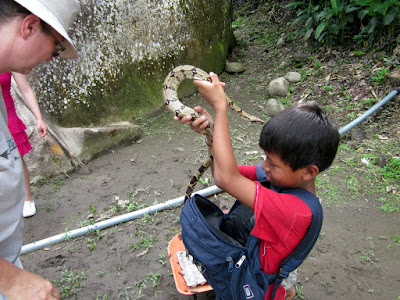 |
| We hiked across this bridge to board a rowboat for the first part of our Quichua adventure. |
We caught a bus from Puyo to Tena, another small edge-of-the-Amazon city that sits at the junction of two rivers and caters to backpackers and adventure tourists. We arrived late in the afternoon on December 23 and caught a taxi from the bus station to the riverside hotel we had chosen from our tour book. It was simple, clean and walking distance to Centro. It was getting dark as we walked into town to look for food, and it being Sunday, we were lucky to find a Chinese restaurant open for dinner. After we ate, we walked around a bit more to familiarize ourselves with the layout, then returned to our room for the night.
The next day, Christmas Eve, we were able to book a tour of the Quichua village outside the neighboring town of Misahuallí. Our guide left his car at a park in Misahuallí and led us across a rickety bridge to a dock where a rowboat was tied. He rowed us around a few bends of the river, pointing out significant trees and wildlife.
 |
| A visitor from Quito holds the banana leaf wrapper while a Quichua woman fills it with chicha pulp to ferment. |
When we reached the Quichua village, we joined several other small groups for a show of native customs that they put on at least once a day. Inside their meeting hall, a large split-bamboo enclosure with a thatched roof and dirt floor, a Quichua woman demonstrated how they make chicha, their traditional drink, from pulverized (in the old days, masticated) and fermented manioc root. Then a group of girls and women performed a tribal dance.
Afterward, the visitors filtered out of the meeting hall and wandered around the village while waiting for lunch to be ready. One little boy from the village approached us carrying a backpack. He invited us to see what he had inside. Larry gave him a coin, and the boy unzipped his pack to reveal the head of a fairly large snake. That cleared a ten-foot circle around the kid, but he reached inside and began unwinding foot after foot of reptile. Would anyone like to hold him, the little showman wondered. I decided to be brave. I let him feed the snake onto my shoulders while I held my arms straight out. When the snake circled its head around and started back toward my chest, I caught it in both hands while Larry caught a picture. Then it glided back into the boy's backpack, waiting for the next group of tourists.
 |
| Wanna see what I have in my pack? |
 |
| Sure, I'll hold your snake. |
 |
| The Quichua kitchen: All the food was cooked on this earthen stove, either over the fire or with heat accumulated in the dirt. |
 |
| Lunch was a whole tilapia steamed in banana leaves, boiled yucca root and a salad of tomatoes and onions. |
 |
| The best thing in Misahuallí was the Capuchin monkeys begging in the trees. |
No comments:
Post a Comment